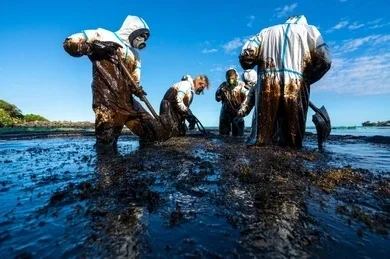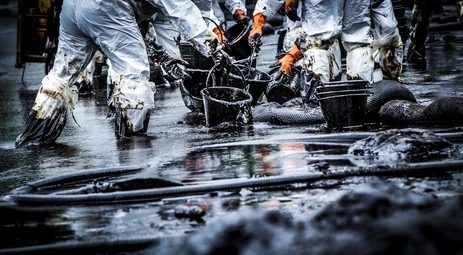The biggest oil spill in US history occurred in April 20, 2010, in the Gulf of Mexico, when the Deepwater Horizon oil rig, operated by British Petroleum (BP), exploded and sank. The biggest oil spill in US history incident caused the deaths of 11 workers and resulted in the discharge of an estimated 4.9 million barrels of crude oil into the Gulf over a period of 87 days.
The explosion was caused by a blowout, which occurred when a surge of natural gas and oil burst through a concrete core that was intended to seal the well. The explosion ignited a massive fire on the rig, which burned for two days before the rig sank.
Efforts to contain and clean up the spill were hampered by the scale of the disaster, the location of the wellhead deep underwater, and the vast size of the affected area. BP and the US government deployed a range of strategies to contain and clean up the oil, including controlled burns, dispersants, and the use of booms to contain the oil slick.
The impact of the spill was significant and far-reaching, with damage to wildlife, fisheries, and the economies of the Gulf states. The cleanup and compensation process took years to complete and cost BP tens of billions of dollars. The incident also led to increased regulation of offshore oil drilling and changes in industry practices to improve safety and prevent future disasters.
The Environmental And Economic Impact Of The Biggest Oil Spill In US History

The environmental and economic impact of the biggest oil spill in US history has been significant, with long-lasting consequences that continue to affect ecosystems and economies in the affected regions. In April 2010, the Deepwater Horizon oil rig, leased by the British multinational oil and gas company BP, exploded in the Gulf of Mexico, leading to the largest oil spill in US history.
This disaster released an estimated 4.9 million barrels of oil into the ocean, with disastrous consequences for the environment and local communities. In addition to the environmental impact, the economic impact of the spill has been immense. The spill had a significant impact on the fishing and tourism industries in the Gulf of Mexico, leading to a loss of jobs and income for many people in the region.
The economic costs of the spill were also felt by BP, which paid a record-breaking $20 billion fine to settle claims related to the disaster. Another significant oil spill that had environmental and economic impacts is the Lario oil and gas spill. In January 2021, the Lario oil and gas company spilled over 20,000 gallons of oil into the Red Deer River in Alberta, Canada.
The spill affected drinking water for nearby communities and wildlife habitats, causing significant environmental damage. When measuring the volume of liquid spilled in an oil spill, various tools and techniques are used, depending on the circumstances. Some common methods include using visual estimates, flow rate measurements, and sonar technology to calculate the volume of spilled oil.
Read Also: Ways To Generate Income From Gaseous Waste
Modern residential oil furnaces have advanced sensors that can detect the presence of flames and adjust the fuel flow to optimize efficiency and reduce emissions. These sensors use advanced technology to ensure that the furnace is burning fuel efficiently and cleanly, reducing the risk of spills and other environmental impacts. By incorporating these technologies, the risk of environmental and economic damage from oil spills can be reduced, ensuring a more sustainable and cleaner energy future.
Oil spills are a significant threat to the environment, often causing long-term damage to ecosystems and wildlife habitats. The release of oil into the ocean can result in the death of marine life, as well as harm to coastal habitats and communities. The economic impact of oil spills can also be significant, with costs related to clean-up efforts, lost revenue for industries such as fishing and tourism, and compensation for those affected.
In the case of the BP oil spill, the company faced intense public scrutiny and legal action as a result of the disaster. The $20 billion fine paid by BP was the largest ever paid by a company to the US government, and was intended to cover damages related to the spill, including those related to environmental restoration and economic losses.
The Lario oil and gas spill is a reminder that even smaller spills can have significant impacts on the environment and local communities. In this case, the spill resulted in the closure of a major water treatment plant and a drinking water advisory for nearby communities. The spill also caused significant harm to local wildlife habitats, including a nearby bird sanctuary.
As the demand for energy continues to grow, it is important to consider the environmental and economic impacts of oil spills and to work towards more sustainable solutions. This includes investing in renewable energy sources and technologies, as well as improving safety standards and regulations for the oil and gas industry.
In addition to technology advancements in oil furnaces, innovations in spill response and clean-up technologies are also critical for reducing the impact of oil spills. This includes the development of more effective containment and recovery systems, as well as improved techniques for cleaning up spilled oil from the environment.
Ultimately, preventing oil spills from occurring in the first place is the best solution for mitigating their environmental and economic impact. This requires a commitment to safety and environmental responsibility from all stakeholders involved in the production, transportation, and use of oil and gas. By working together to develop and implement more sustainable energy solutions, we can help protect the environment and support economic growth in a more sustainable and responsible way.
The impact of oil spills goes beyond the immediate damage to the environment and local economies. The long-term effects of oil spills can persist for decades, affecting the health of ecosystems and communities for years to come.
For example, the BP oil spill fine in the Gulf of Mexico resulted in significant damage to marine life, including dolphins, sea turtles, and pelicans. The long-term effects of the spill on these populations are still being studied, but it is clear that the impact will last for many years.
Read Also: Ways To Generate Income From Hazardous Waste
The economic impact of oil spills is also significant, particularly for industries such as fishing and tourism that rely on healthy ecosystems and clean water. In the case of the BP oil spill, the tourism industry in the Gulf of Mexico suffered significant losses, with many hotels and resorts reporting cancellations and reduced revenue in the years following the spill. The fishing industry in the region was also affected, with many fishermen reporting reduced catches and lost income as a result of the spill.
To mitigate the impact of oil spills, it is important to invest in research and technology that can help prevent spills from occurring, as well as improve the response and clean-up efforts in the event of a spill. This includes developing and implementing more effective safety standards and regulations for the oil and gas industry, as well as investing in research and development of new technologies for oil spill response and clean-up.
In addition, it is important to continue to work towards a more sustainable energy future, with a focus on developing and implementing renewable energy sources and technologies. By reducing our dependence on oil and gas, we can help reduce the risk of future spills and support a more sustainable and responsible energy future.
The environmental and economic impact of oil spills is significant, highlighting the need for continued efforts to prevent spills from occurring, as well as improve our response and clean-up efforts in the event of a spill. By working together to develop and implement sustainable energy solutions, we can help protect the environment and support the long-term health of our communities and economies.
One of the key challenges in preventing oil spills is the complex network of infrastructure and transportation involved in the oil and gas industry. Oil is often transported across long distances via pipelines, tankers, and other means, and this transportation can be vulnerable to accidents or malfunctions that can lead to spills.
To mitigate these risks, it is important to invest in safety and maintenance for these transportation systems, as well as implement effective monitoring and response systems to quickly detect and address any issues that may arise.
The use of advanced technologies can also play a key role in preventing oil spills. For example, modern residential oil furnaces sense the flames using: electronic sensors, which can help prevent fires and reduce the risk of spills. Similarly, new technologies for oil and gas production and transportation can help improve safety and reduce the risk of spills.
In the event of an oil spill, effective response and clean-up efforts are critical for minimizing the impact on the environment and local communities. This requires the use of specialized equipment and trained personnel to contain the spill and remove oil from the environment.
To measure the volume of oil spilled, a variety of methods can be used, including aerial surveys, remote sensing technologies, and on-the-ground assessments. Accurate measurement of the volume of oil spilled is important for understanding the extent of the damage and developing effective clean-up strategies. It’s important to know what is used to measure volume of liquid when conducting experiments.
In conclusion, the environmental and economic impact of oil spills is significant, highlighting the need for continued efforts to prevent spills from occurring, as well as improve our response and clean-up efforts in the event of a spill.
By investing in technology and sustainability, as well as working together to develop more responsible energy solutions, we can help reduce the risk of future spills and protect the health of our environment and communities.
Read Also: Cran Grape Juice: A Powerful Antioxidant-Rich Drink for Your Health

